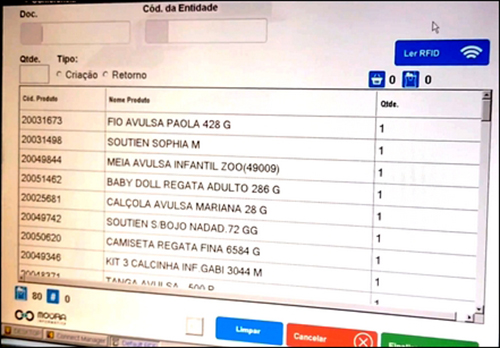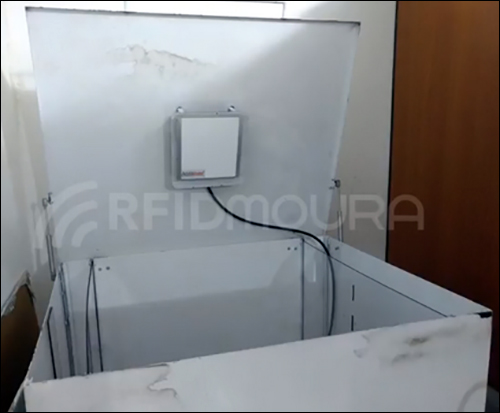Mari Semi Jewels, Lingerie and Cosmetics Group, a company focused on the sale of door-to-door products, has a network of more than 2,000 consultants in several municipalities in the state of São Paulo, Brazil. The company has recently gained agility in its checkout process, thanks to the adoption of a radio frequency identification solution from RFID Moura.
According to Alex Casado, a managing partner at the Mari Group, the process of completing a purchase, which previously took around 30 minutes, can now be completed within no more than six minutes, and with a higher degree of reliability. “There are other benefits,” he says, “such as making each item unique, which opens up a gigantic range of options, such as offering more efficient assurance of each item and complete traceability.”
The initial challenge was to expedite the closing of consultants’ accounts and free up space in the warehouse, in order to stock other products. Prior to the RFID system’s deployment, six employees were involved because the whole process was manual. Now, with RFID, it is possible to increase efficiency with just four employees. More than 400,000 tags have been put into use since the deployment.
“It’s difficult, at first, to have the perception of how a label that costs 30 times more than the conventional one can give a return on investment,” Casado states. “After this discovery [of RFID’s efficiency], in my case, the biggest challenge was the exchange of labels, because my stock is approximately 80 percent outside the company.”
The activity of replacing common tags with those containing smart RFID chips lasted for three months. During this period, the company organized and parameterized its enterprise resource planning (ERP) system and adapted all internal processes to make the most of the new technology.
“The next step,” Casado reports, “is to take RFID to all of our product lines and, from then on, to apply the already optimized improvements in warranty processes and traceability, and maybe even create mobile units to optimize inventory and what we can imagine.”
Prior to the RFID system’s installation, a consultant would select goods he or she wished to consign, then put them in a bag and hand them to an employee to count the number of pieces. The total would be written down on a piece paper, which would be affixed to the bag. A worker would pick up all bags from the consultant and read all products, one by one, via the items’ bar codes, and the data would be entered into the company’s inventory-management system. The process took 30 minutes to complete.
With RFID, in addition to this time being reduced to six minutes, several problems with bar codes were eliminated. A consultant previously had to wait for hours for the process to be completed, from start to finish—and he or she had to close previous consignments, so the process took even longer.
Without RFID, it was often impossible to close a consultant’s account on the same day, due to the volume involved. Therefore, it took more time to release an employee to take a new consignment of products to be sold. “It was common to have an error while closing sales of consultants,” Casado says, “which caused discomfort—and when the process was for another day, it was even worse.”
The process took up a lot of space, which was eliminated with RFID. Now, with the technology up and running, there is simply a four-antenna RFID reading box and an Acura EDGE 50 reader.
RFID Moura developed an application to count the quantity of pieces inside the bag, an option to read the parts in the box, the ability to compare the number of pieces counted by the employee with the number read by the box, and a function for transmitting the readings to the consignment-control system.
“We integrated the RFID Moura solution into the label-printing screen in the company’s system,” says Tales Boalim, RFID Moura’s technology and innovation manager. “They use a Zebra Technologies ZD500R printer, and now they have purchased 250,000 CCRR RFID tags to tag the stock of lingerie.
With the RFID system, after an employee counts the amount of lingerie items assigned by the consultant, he or she enters the bag’s ID and the quantity of parts in the application created by RFID Moura. The bags are transferred to the counting area, where another employee reads all client bags in the box instantly, at the touch of a button. “After reading all the client’s bags,” Boalim explains, “the employee presses a button to transmit the products read to the company’s system and generates a code to display the status on the consignment screen or on the merchandise return screen.”
Return on investment (ROI) occurred after 10 months, according to the company. Following a year and a half of use, the department is typically staffed by four to six employees. According to the company, it is possible to carry out the process with only two employees, though it keeps four on hand in case of unforeseen events.
With four employees, though, there are idle moments. When this happens, the firm transfers one employee to another area. “Each RFID readout shows all captured items and checks the amount read by the box with the amount reported by the employee,” Boalim states. “At the end of the year, when sales increased, it was necessary to increase the number of employees in the counting area and have them work overtime. With the implementation of RFID, at the end of 2017 the department worked with all four employees, and there was no overtime.”





